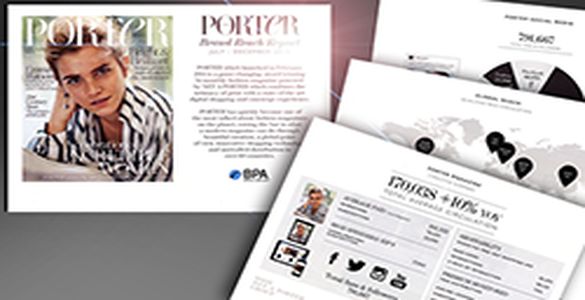In 2012, I tweeted this: Online fashion retailer Net-a-Porter is planning to launch a printed magazine within the next 12 months. Little did I know this was foreshadowing and involved our client, BPA®.
BPA® Worldwide is in the business of providing assurance, serving media companies, advertisers and their agencies who created and own BPA since 1931. Our company works with BPA to help the advertising community understand the value publishers and media companies bring to the table. We created http://www.bpamakesmedia.com to help accomplish that.
At a recent meeting, our client produced a sample for a new kind of audit coming out of their UK offices for a magazine. The name of that magazine? Porter!
Those familiar with the BPA Brand audit will be amazed at this new format, which is actually a compelling sales presentation for Porter, and was, according to our client, largely driven by Porter. It presents the magazine data in highly visual context, making it irresistible to a media buyer. Some highlights:
- Cover. This is co-branded by Porter and BPA. The “Brand Reach Report” of course is BPA’s, but the BPA logo, while subordinate (as it should be as “auditor”) provides the “assurance” that what the reader will see has been verified! For Porter, there’s a cover of the issue that was audited, bold like its brand.
- Spreads. The audit opens vertically – not horizontally like a traditional magazine. This gives the data a “billboard” appearance, much like the broadsides that were and are still sometimes used in direct mail packages. It’s easy to read, and bold, like the brand being presented.
- Statistics. Not all statistics presented are audited by BPA; however, those that are not have a footnote for the source, making this a compelling presentation of truth.
The report itself is 20 pages long! Every spread is a digestible gulp of information. So why aren’t other publishers doing this?
The answer is Porter was an e-commerce platform first, and magazine second. They didn’t inherit a bunch of rules about magazine publishing – they saw a need for a magazine based on their audience, and, they gave them one. So, for example, the magazine isn’t available online (the print version isn’t necessarily the same as the online version). You won’t find the audited print copy on the website (smart, huh?). But you will find it if you pay for it; however, you will find loads of other content in a “digital” magazine format on the website. Print and digital — well, they are different. One smart marketer.
Perhaps the real question is, how are print magazines going to go in the other direction – that is, to e-commerce? I have some ideas…but what are yours? Let me know what you think!
